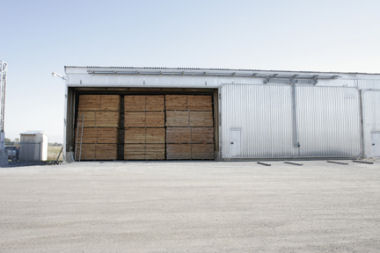Kiln Drying
To understand kiln drying and its importance in making wood mouldings it is important to understand the nature of trees and wood. Trees grow with their roots in the ground and leaves in the air and these roots collect moisture and nutrients from the soil and ship them through vessels or fibers up through the trunk and branches to the leaves. In composition, these vessels are similar to stalks of celery. The leaves mix the moisture and nutrients with carbon dioxide and sunlight (photosynthesis) to give oxygen back into the atmosphere and create food for the tree that is transfered back to the trees roots.
The trees fibers are moisture laden but shortly after being cut down the tree begins to dry out just like a flower wilts after being picked. As the tree dries the fibers and vessels within the tree shrink in thickness or diameter and only marginally lengthwise.
Moisture and Shrinkage
The tree is then immediately sawed into boards approximately 1 " thick x 12" wide of various lengths. If it were weighed on a scale it would weigh approximately 1OO pounds. The boards are then stacked with thin strips of wood between the rows of wood to keep the board straight and allow for air drying. This stack is left standing for up to six months. If weighed it would weigh 50 pounds. Thus, fifty pounds of water has evaporated.
To ensure the raw wood fibre used in the manufacturing process does not have an excess of moisture Alexandria Moulding has constructed its own kiln dryers. Wood has a naturally high ambient water content. Even after a tree has been cut down it retains water in its cellular structures as noted above. Trying to cut wet wood is very difficult. It is important for the wood to be kiln dried for the various saws and moulding heads to cut and shape the moulding profile in an optimum manner.
The lumber is then loaded into a kiln dryer. Alexandria Moulding's kiln dryers are comprised of 4 different cells. Each cell can hold up to 3 or 4 truckloads of lumber. Within the kiln there are fans to circulate the air, steam pipes to create heat, and live steam to induce moisture. Highly-trained specialists are in charge of this operation. The humidity will gradually be lowered and the temperature increased over a time period of between 15-28 days until our boards reach the optimum moisture content for manufacturing. This spectrum is between 6-12% depending on specie. The boards are much too hot to touch and must be left to cool down for a few hours. If weighed again the board may weigh in at about 35 - 40 pounds and will have lost about 1/32" in thickness and 3/4" from its width.
It is important to control moisture content and to not dry out the board completely to ensure some flexibilty in the wood fibers. Precision kiln-drying is a primary responsibility of a wood moulding manufacturer to lessen machining problems and ensure a consistent quality product for our customers. Each fiber in the living tree has now shriveled or collapsed. This is why the board is narrower and a little bit thinner, but not shorter.
If dampness is introduced via the floor or ground this moisture will be drawn into the end grains of the wood like a straw sucking up a milkshake. The fibers will accept this moisture and start to swell; long-term dampness will cause all the boards to swell called expansion. An expanded piece of moulding will then shrink again resulting in cracks within the wood. This is why we precision kiln dry our wood and store it properly to optimize the manufacturing process and improve the quality of our products.
